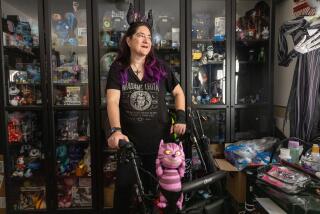Theme Parks Wait for New Safety Rules
- Share via
More than three years after a hard-fought battle to pass an amusement-park safety law, the state has not put in place the regulations to enforce it.
As regulators prepare to meet Thursday for another round of hearings, they face criticism that they have bowed under the weight of industry lobbying and have weakened previously planned safety rules.
“There was enough public pressure to get the law passed, but there’s no strong, politically powerful lobby to protect the integrity of it,” said Kathy Fackler, a La Jolla resident whose son was injured at Disneyland in 1998, and who later founded the advocacy group Saferparks. “What I’m seeing happen is the politically powerful folk are picking critical pieces out of it or putting critical loopholes in it.”
Fackler will be at Thursday’s hearing in Sacramento to press for tougher rules.
Victoria and David Zucker, parents of a young boy who was severely brain damaged almost two years ago after he toppled from a Disneyland ride and was pinned under the car, also are expected to attend.
The 1999 law gives the state Division of Occupational Safety and Health authority to investigate accidents at amusement parks and require safety changes.
Parks are required to report injuries and submit to routine ride inspections.
Although the law took effect in January 2000 and theme parks are reporting accidents, the specific rules and regulations are far from complete.
The first set of regulations--called administrative regulations--has been adopted and outlines the requirements for the reporting of accidents and regular inspections of rides.
On Thursday, the state Occupational Safety and Health Standards Board will review the second set of regulations, a set of instructions and requirements addressing ride safety, such as maintenance records. A third set of regulations, yet to be drawn up, will address penalties for parks that fail to comply.
As of Friday, no industry officials had filed public comments on the regulations.
Disneyland Resort officials said the regulations have “evolved very well” and any concerns can be resolved. Disneyland spokesman Ray Gomez would not specify those concerns, but said, “We look forward to seeing the regulations finalized and implemented.”
Despite the lengthy process, the division’s special counsel, Len Welsh, said he would rather be deliberate and lay solid groundwork for the program, than throw together incomplete or unclear regulations. “We are putting together a program for the first time,” Welsh said. “It’s not something you rush ahead to do.”
The process has been delayed because of several wording changes. Each time major changes are made, the public is given additional time to comment.
The program has already completed several accident investigations and some ride inspections.
These regulations stay true to the intent of the law, Welsh said, and include strong language about restricting some rides or providing additional warnings.
A person’s weight, height, age or health condition could create higher risks for certain rides and each park must devise a plan to determine who can ride. For example, some rides might have restraints that don’t work for very heavy people; in such a case, the park must decide whether to change the restraints or prohibit larger people from riding.
“I personally don’t think [the regulations] are watered down,” Welsh said. “If anything, I think they’re stronger than they were last year.”
A key area of concern for Fackler is the requirement that parks must report serious accidents. Before the law passed, the public had no way of knowing how many accidents occurred at parks, which have consistently described themselves as one of the safest forms of family entertainment.
The regulations say that parks must immediately report ride accidents that result in injury requiring medical service beyond first aid.
Fackler described that wording as vague and said it has already resulted in varying interpretations of what must be reported. She said she fears that some injuries, such as whiplash or brain injuries, may fall through the cracks.
So far, Welsh said, parks seem to be reporting everything; and some are even going beyond what the law requires. Parks that fail to report accidents can be cited by the state. Once final regulations are in place, parks may also be subject to fines.
Fackler said she is also alarmed by the state’s assessment that the regulations could have a “significant economic impact on businesses.”
If that proves true, the board can consider exempting certain parks from parts of the law.
For Fackler, exemption is a frightening possibility.
In Florida, for example, the largest theme parks--Disney World, Universal and Busch Gardens--are exempt from mandatory accident reporting, although they have volunteered to submit a quarterly report. Even so, the state has no power to investigate accidents.
“It looks like they’re looking to justify an exemption for theme parks,” Fackler said. “It’s at the very least an open door.”
According to the state’s figures, ongoing annual costs per ride for compliance would be about $759 per ride--an amount Fackler contends can be easily absorbed by multimillion-dollar amusement parks.
Welsh said the state is required to assess the financial impact of regulations and he does not believe it will lead to any exemptions. “If [the financial impact] is significant, it’s barely significant,” he said. “We’re required to adopt the regulations anyway. We don’t think there’s any reasonable alternative to what we’ve proposed.”
More to Read
Sign up for Essential California
The most important California stories and recommendations in your inbox every morning.
You may occasionally receive promotional content from the Los Angeles Times.










